
Cortinarius is a globally distributed genus of mushrooms in the family Cortinariaceae. It is suspected to be the largest genus of agarics, containing over 2,000 widespread species. A common feature among all species in the genus Cortinarius is that young specimens have a cortina (veil) between the cap and the stem, hence the name, meaning curtained. Most of the fibres of the cortina are ephemeral and will leave no trace once gone, except for limited remnants on the stem or cap edge in some species. All have a rusty brown spore print. The common names cortinar and webcap refer to members of the genus. Due to dangerous toxicity of several species and the fact that it is difficult to distinguish between various species of the genus, non-expert consumption of mushrooms from the genus is discouraged.

Cortinarius caperatus is an edible mushroom of the genus Cortinarius found in northern regions of Europe and North America. It was known as Rozites caperata for many years before genetic studies revealed that it belonged to the genus Cortinarius. The fruit bodies appear in autumn in coniferous and beech woods as well as heathlands in late summer and autumn. The ochre-coloured cap is up to 10 cm (4 in) across and has a fibrous surface. The clay-colored gills are attached to the stipe under the cap, and the stipe is whitish with a whitish ring. The Latin specific name, caperatus, means wrinkled, and refers to the distinctive texture of the cap. The flesh has a mild smell and flavor.

Emil Johann Lambert Heinricher was an Austrian botanist from Laibach (Ljubljana).
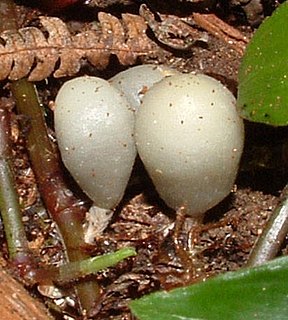
Psilocybe weraroa is a secotioid fungus in the family Hymenogastraceae. It is endemic to New Zealand. This species is closely related to Psilocybe cyanescens and is in both the section Cyanescens and the Cyanescens phylogenetic clade. As a bluing member of the genus Psilocybe it contains the psychoactive compounds psilocin and psilocybin.

Cortinarius violaceus, commonly known as the violet webcap or violet cort, is a fungus in the webcap genus Cortinarius native across the Northern Hemisphere. The fruit bodies are dark purple mushrooms with caps up to 15 cm (6 in) across, sporting gills underneath. The stalk measures 6 to 12 centimetres by 1 to 2 cm, sometimes with a thicker base. The dark flesh has a smell reminiscent of cedar wood. Forming symbiotic (ectomycorrhizal) relationships with the roots of various plant species, C. violaceus is found predominantly in conifer forests in North America and deciduous forests in Europe.

Cortinarius archeri is a species of mushroom in the genus Cortinarius native to Australia. The distinctive mushrooms have bright purple caps that glisten with slime, and appear in autumn in eucalypt forests.
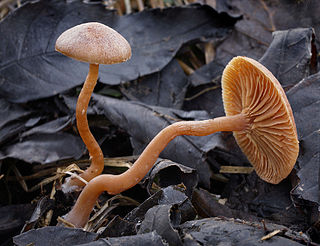
Tubaria is a genus of fungi in the family Tubariaceae. The genus is widely distributed, especially in temperate regions. Tubaria was originally named as a subgenus of Agaricus by Worthington George Smith in 1870. Claude Casimir Gillet promoted it to generic status in 1876. The mushrooms produced by species in this genus are small- to medium-sized with caps ranging in color from pale pinkish-brown to reddish-brown, and often with remnants of the partial veil adhering to the margin. Mushrooms fruit on rotting wood, or, less frequently, in the soil. There are no species in the genus that are recommended for consumption.

Cortinarius anomalus, also known as the variable webcap, is a basidiomycete fungus of the genus Cortinarius. It produces a medium-sized mushroom with a grayish-brown cap up to 5 cm (2 in) wide, gray-violet gills and a whitish stem with pale yellow belts below. The mushroom grows solitarily or in scattered groups on the ground in deciduous and coniferous forests. It is found throughout the temperate zone of the northern hemisphere.
Stephanopus is a genus of fungi in the family Cortinariaceae. The genus, circumscribed by mycologists Meinhard Moser and Egon Horak in 1975, contains five species found in South America.

Meinhard Michael Moser was an Austrian mycologist. His work principally concerned the taxonomy, chemistry, and toxicity of the gilled mushrooms (Agaricales), especially those of the genus Cortinarius, and the ecology of ectomycorrhizal relationships. His contributions to the Kleine Kryptogamenflora von Mitteleuropa series of mycological guidebooks were well regarded and widely used. In particular, his 1953 Blätter- und Bauchpilze [The Gilled and Gasteroid Fungi ], which became known as simply "Moser", saw several editions in both the original German and in translation. Other important works included a 1960 monograph on the genus Phlegmacium and a 1975 study of members of Cortinarius, Dermocybe, and Stephanopus in South America, co-authored with the mycologist Egon Horak.

Cortinarius porphyroideus, commonly known as purple pouch fungus, is a secotioid species of fungus found in Australia and in beech forests of New Zealand. It was one of six species that appeared as part of a series depicting native New Zealand fungi on stamps, released in 2002.
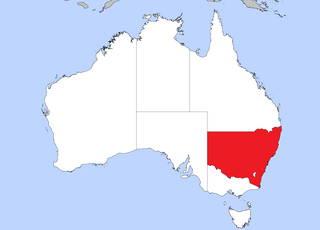
Cortinarius maculobulga is a species of truffle-like fungus in the family Cortinariaceae. Found only in New South Wales, Australia, it was described as new to science in 2010.
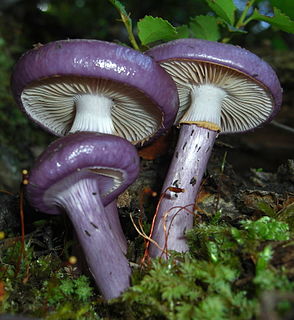
Cortinarius magellanicus is a species of agaric fungus in the family Cortinariaceae. It was described as new to science by mycologist Carlos Luigi Spegazzini in 1887. It has been found in South America and New Zealand, although collections made from the latter location appears to be genetically distinct from South American material.
Egon Horak is an Austrian mycologist who has described more than 1000 species of fungi, including many from the Southern Hemisphere, particularly New Zealand and South America. He was an executive editor of the scientific journal Sydowia from 1975 to 1989, and a member of the editorial board afterwards.
Entoloma moserianum is a species of fungus in the family Entolomataceae. Found in the Netherlands where it grows on the ground in deciduous forests, it was described as new to science in 1983 by Machiel Noordeloos. The species is classified in Entoloma section Entoloma, and is similar to E. sinuatum. The fruit bodies of E. moserianum are characterized by pale colors, yellow spots on the cap, gills, and stipe, and gill edges that are partially to completely sterile. Its spores measure 9.3–11.5 by 8.1–9.3 μm The specific epithet honors Austrian mycologist Meinhard Michael Moser.
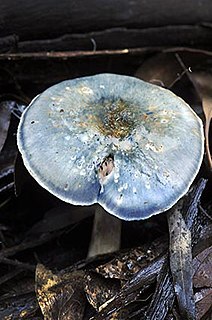
Cortinarius metallicus, originally described as Rozites metallica and commonly known as the steel blue rozites, is a species of mushroom native to Australia.

Cortinarius subcastanellus is a species of mushroom native to New Zealand. It was originally described in 1982 as Rozites castanella by mycologists Egon Horak and Grace Marie Taylor.
Grace Marie Taylor née Bulmer was a New Zealand mycologist and botanist as well as a scientific illustrator. She described several new species of fungi and published and illustrated books on New Zealand fungi and plants.












